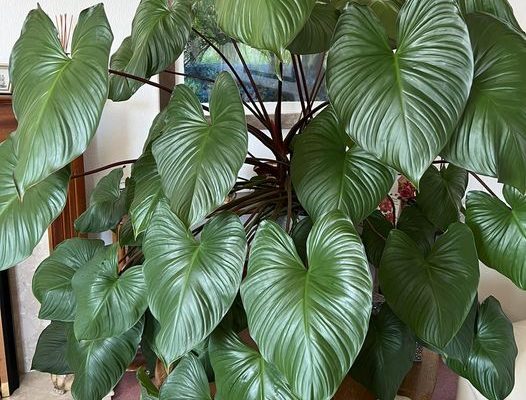It’s a fast grower and needs proper support from a moss or bamboo pole, trellis, or other vertical support.
Of course, the striking yet simple coloration sets Philodendron erubescens’ Red Emerald’ apart.
This cultivar’s petioles, midribs, and veins are wine-colored, and the glossy leaves are heart to arrow-shaped and measure an impressive 9″ to 18″ inches long.
It’s very similar to its parent plant, although it has an aggressive climbing habit.
Unlike its sister, the ‘Pink Princess,’ it lacks pink variegation in favor of leaves that shift from burgundy to green as they mature.
Note that there’s some debate regarding whether ‘Red Emerald’ and ‘Green Emerald’ should be considered the same cultivar, as the leaves on both can appear green in low light settings.
However, it could be argued that ‘Red Emerald’ is an exception to the second rule.
The deep red spathe might steal your heart if you spot it blooming in late spring to early summer.
As a result, they tend to be sensitive to direct light and can easily scorch.
You can usually gauge if your ‘Red Emerald’ is getting too much or too little light by the color of its leaves.
Too much light will cause the leaves to turn yellow, while not enough will fade them to dark green.
While this plant can survive at a 40% percent humidity level, 60% to 80% percent is ideal.
You can augment the plant’s humidity with a pebble tray, humidifier, or by grouping it with other plants.
Philodendron erubescens ‘Red Emerald’ is highly cold-intolerant and can die when temperatures fall below 50° degrees Fahrenheit.
However, some growers in southern Florida have noted it can bounce back if exposed to brief dips in temperature.
While this means the plant technically will only thrive in USDA hardiness zone 12 and parts of zone 11a, it is often grown in zones 10 to 11 when some degree of shelter is provided from the cold.
It has had little success in zone 9b, but cooler zones can bring a potted specimen outdoors during warm weather if they want to enjoy it in their garden.
Indoors, ‘Red Emerald’ prefers a comfortable temperature range of 60° to 85° degrees Fahrenheit, with day temperatures slightly warmer than night temps.
Watering And Feeding
All of the disease risks of your ‘Red Emerald’ are caused by improper watering.
Thankfully, you can use the soak-and-dry technique both indoors and outdoors.
If you aren’t familiar with this technique, it begins with you sticking your finger in the soil to check the dryness depth.
When it comes to ‘Red Emerald, it’s time to water once the soil is dry 1” inch down.
Follow these steps:
- Add the water slowly and evenly, working your way around the container (or plant, if growing in the garden).
- Ensure you don’t get the leaves wet.
- Stop when the soil isn’t absorbing as fast as you pour or see water beginning to seep from the drainage holes.
- Note that you can miss one or two waterings with this plant and cause no lasting harm.
- Be sure to cut back on watering when the plant goes dormant.
- As for fertilizer, ‘Red Emerald’ can go without food if the soil is good enough, but you won’t get the most out of it.
Instead, aim for a balanced liquid houseplant fertilizer (10-10-10 or 15-15-15 NPK works best) cut to half strength once per month in spring and summer.
Don’t feed the plant in fall or winter, as the plant will be dormant at this time.
Soil And Transplanting
A light, well-draining soil is vital for a healthy ‘Red Emerald.’
You can amend garden or potting soil with an aggregate such as coarse sand, perlite, or vermiculite to help keep the soil from compacting.
Likewise, you may add an organic component such as coco coir, orchid bark, or moss to create richer soil.
African violet ort orchid potting mixes are a good choice if you don’t want to do extra mixing.
You can also go a soilless route using only sphagnum moss or a mix of peat and vermiculite.
This plant can handle a wide pH range from acidic 5.8 to a slightly alkaline 7.5, so it’s usually best to aim for the middle ground at around 6.5.
When adding an organic component, you can use peat moss to make the soil slightly more acidic or sphagnum moss to make it slightly more neutral.
Juvenile plants grow rapidly and will need an annual spring repotting.
Graduate the container to one size larger and replace the potting medium.
Once it matures, you’ll only need to repot every 2 to 3 years.
A telltale sign it needs repotting is if you see roots poking out of the drainage holes or surface of the potting medium.
-
Grooming And Maintenance
Philodendrons are well known for their low maintenance needs.
For ‘Red Emerald,’ proper support is essential, and you may find yourself pruning it a little more often than slower growers.
Remove any damaged or diseased leaves.
You may also wish to trim back any leggy petioles.
The best time for pruning an outdoor plant is in the spring, but an indoor specimen can be groomed at any point during the growing season.
Note that you may also have to occasionally wipe the leaves of indoor plants to prevent dust from hindering photosynthesis.
How to Propagate Philodendron Red Emerald?
The most common method of propagating this cultivar is cuttings, although it can also be cultivated via air layering or seeds (if you’re lucky enough to get some).
Red Emerald Philodendron Pests Or Diseases
While not drought-hardy, this plant can handle a few missed waterings.
However, it cannot stand cold temperatures, and even light frost will kill it.
The parent plant has escaped and naturalized in Hawaii, but there are currently no areas where the plant is restricted or considered a nuisance plant.
‘Red Emerald’ is primarily pest and disease resistant, although it can suffer root rot or fungal infections when overwatered or the leaves get wet.
- Pests can take residence if the plant is sick or kept near an already-infested plant.
Examples of these are:
- Aphids
- Mealybugs
- Scale
- Spider mites
- Whiteflies
As with all philodendrons, this plant contains high levels of calcium oxalate crystals.
These indigestible crystals usually produce mild symptoms in adults (but may lead to kidney stones), but the smaller you get, the more deadly they become.
Children can suffer several digestive issues or even dizziness and (in extreme cases) coma, while dogs get severely ill and cats may die.
Thus, keeping the plant away from any curious mouths is important.
Uses Of Philodendron Erubescens Red Emerald
Epiphytes are avid climbers and can brighten up a corner or add a class when scrambling up a pole at the corner of a bookcase.
- They can be kept in a hanging basket but may be less impressive than other philodendrons when left hanging.




